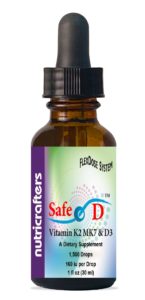Are You Getting Enough Vitamin D?
A report released November 30, 2010 by the new Institute of Medicine (IOM), the health arm of the National Academy of Sciences, noted that few people are vitamin D deficient. But they are so wrong. Michael F. Holick, M.D., PhD., the world’s leading expert on vitamin D estimates that more than 200 million Americans are deficient in this essential vitamin and are suffering from chronic diseases and life-threatening illnesses, including heart disease, diabetes, depression, obesity and osteoporosis as a result.
Prior to the newly released guidelines, the Recommended Daily Allowance (RDA) for vitamin D was 200 IU for children and adults, up to 50 years of age. For older adults it was 400 IU. Now the recommended dosage is 600 IU for children, pregnant and breastfeeding teens and women, and adults 19 to 70 years old. The new RDA for adults 71 years of age and older is 800 IU. This is the government’s first official vitamin D recommendation since 1997. It’s better, but still way too low.
Guideline researcher Clifford J. Rosen, MD, senior scientist at the Maine Medical Center Research Institute in Scarborough, says: “We believe that taking in amounts larger than 600 to 800 IU a day has no extra benefit for bones.”1 But what about all the hundreds of studies showing that much higher amounts are not only safe, but protective against a whole slew of diseases?
For instance, take the study from the University of California, Davis that calls for a five-fold increase of vitamin D intake during the winter. After studying young adults for a period of 7 to 8 weeks in the fall, winter, spring and summer in Davis, California, the researchers concluded that African Americans with low sun exposure need 2,100 to 3,100 IU of vitamin D per day, year round. Individuals of Eastern European ancestry with high sun exposure need 1,300 IU of vitamin D intake in the winter. These amounts are calculated based on the goal to achieve blood vitamin D levels of at least 75 nanomoles per liter, which would fall in the range of what is considered optimal.2 (A vitamin D deficiency is defined by some as below 50 nmol/L.) (The vitamin D levels were predicted using a computational model based on sun exposure and skin reflectance.)

Interestingly, the Vitamin D fact sheet on the Institutes of Health website states that “In healthy adults, vitamin D at doses up to 4,000 IU is safe. (The safe amount is 1,000 IU for infants in the first six months of life and goes up as you get older to 4,000 IU in children age 9-13 years.)3
The big question is why the Institute of Medicine is not recommending higher levels of vitamin D intake for Americans when there are hundreds of studies showing that higher intake is associated with lower health risks, across the board. Since many of these studies revealed that getting too little vitamin D correlates to higher risk of heart disease and cancer, supplement sales of vitamin D shot up to $430 million last year, an increase of 82%, according to a report by Katie Couric on the CBS Evening News (November 30, 2010).
Could the answer be that raising the RDA for vitamin D is a way to help weaken Big Pharma’s business model by making people healthier? The timing of the announcement is especially suspicious given that vitamin D supplementation has been found to lower risk of getting the flu, and we are headed smack into flu season.
If you really want to be sure about your own vitamin D levels, ask your doctor to do a blood test. Until then, play it safe and take a vitamin D3 supplement to support your overall health, ward off cardiovascular disease, cancer, osteoporosis and the seasonal flu.
Related Articles
References
- 1. Mann, D. Guidelines Call for Increase in Vitamin D. WebMD Health News.
- Hall LM, Kimlin MG, Aronov PA, Hammock BD, Slusser JR, Woodhouse LR, Stephensen CB. Vitamin D intake needed to maintain target serum 25-hydroxyvitamin D concentrations in participants with low sun exposure and dark skin pigmentation is substantially higher than current recommendations.J Nutr.2010 Mar;140(3):542-50. Epub 2010 Jan 6.
- 1. Office of Dietary Supplements, National Institutes of Health. Dietary Supplement Fact Sheet: Vitamin D.
